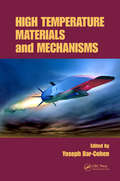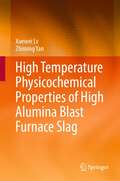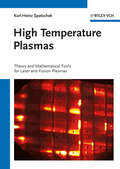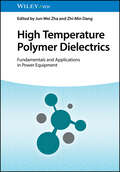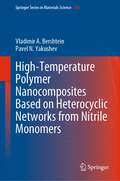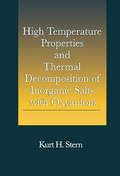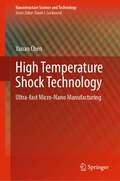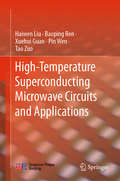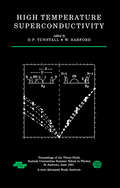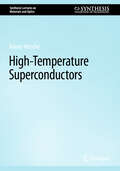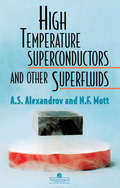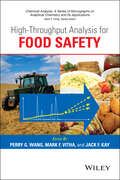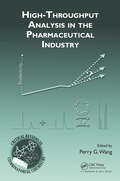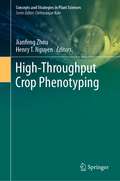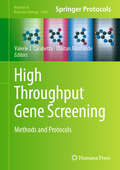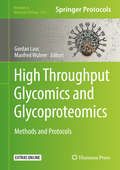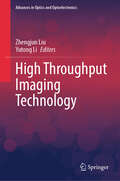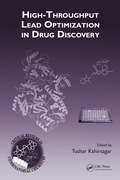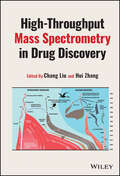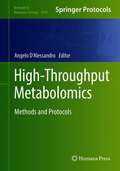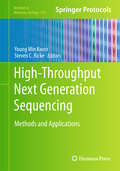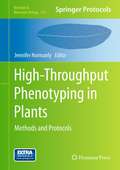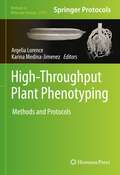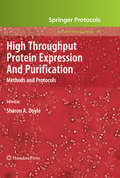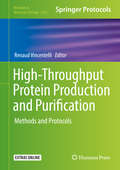- Table View
- List View
High Temperature Materials and Mechanisms
by Yoseph Bar-CohenThe use of high-temperature materials in current and future applications, including silicone materials for handling hot foods and metal alloys for developing high-speed aircraft and spacecraft systems, has generated a growing interest in high-temperature technologies. High Temperature Materials and Mechanisms explores a broad range of issues relate
High Temperature Physicochemical Properties of High Alumina Blast Furnace Slag
by Xuewei Lv Zhiming YanThis book presents the physicochemical properties and structure of high-alumina slag in the ironmaking process. The book consists of seven chapters demonstrating the effect of Al2O3 on the properties and structure of slag. Based on experimental research and practical requirements, a revolutionary technical route for blast furnace smelting of high-alumina iron ore is proposed. The book presents the scientific basis and offers theoretical guidance for the large-scale utilization of high-alumina iron ore in ironmaking process. Therefore, it is of interest for not only academic researchers but also practitioners in this field.
High Temperature Plasmas: Theory and Mathematical Tools for Laser and Fusion Plasmas
by Karl-Heinz SpatschekFilling the gap for a treatment of the subject as an advanced course in theoretical physics with a huge potential for future applications, this monograph discusses aspects of these applications and provides theoretical methods and tools for their investigation. Throughout this coherent and up-to-date work the main emphasis is on classical plasmas at high-temperatures, drawing on the experienced author's specialist background. As such, it covers the key areas of magnetic fusion plasma, laser-plasma-interaction and astrophysical plasmas, while also including nonlinear waves and phenomena. For master and PhD students as well as researchers interested in the theoretical foundations of plasma models.
High Temperature Polymer Dielectrics: Fundamentals and Applications in Power Equipment
by Jun-Wei Zha Zhi-Min DangHigh Temperature Polymer Dielectrics Overview on how to achieve polymer dielectrics at high temperatures, with emphasis on diverse applications in various electrical insulation fields High Temperature Polymer Dielectrics: Fundamentals and Applications in Power Equipment systematically describes the latest research progress surrounding high-temperature polymer dielectric (HTPD) materials and their applications in electrical insulation fields such as high-temperature energy storage capacitors, motors, packaging, printed circuit board, new energy power equipment, and aerospace electrical equipment. The comprehensive text provides a description of the market demand and theoretical research value of HTPDs in electrical equipment and enables readers to improve the performance and design of existing HTPD materials, and to develop efficient new high temperature polymer dielectric materials in general. Specific sample topics covered in High Temperature Polymer Dielectrics include: Thermal and electrical properties of high-temperature polymers, and the excellent thermal stability, mechanical properties, and long service life of polymer dielectrics Why fluorinated polymers are more thermally stable than their corresponding hydrogen-substituted polymers Static Thermomechanical Analysis (TMA), a technique for measuring the functional relationship between the deformation of the materials and the temperature and time under different actions Polyetheretherketone (PEEK), a semi-crystalline polymer material with ether bonds and ketone carbonyl groups in molecular chains Providing a complete overview of the state-of-the-art high temperature polymer dielectrics, with a focus on fundamental background and recent advances, High Temperature Polymer Dielectrics is an essential resource for materials scientists, electrical engineers, polymer chemists, physicists, and professionals working in the chemical industry as a whole.
High-Temperature Polymer Nanocomposites Based on Heterocyclic Networks from Nitrile Monomers (Springer Series in Materials Science #334)
by Vladimir A. Bershtein Pavel N. YakushevThis book presents an overview of polymer nanocomposites for use in various high-temperature applications. Specifically, it focuses on the structure and physical properties of nanocomposites based on heterocyclic matrices derived from nitrile monomers such as cyanate esters or phthalonitriles. Due to increasing interest in new heat-resistant, lightweight materials for use in extreme conditions, such as in aeronautics, microelectronics, and various industrial machinery, the high thermal stability of heterocyclic polymer networks, in particular, has attracted much attention from materials researchers and engineers. Featuring a comprehensive review of the most recent advances in research on the structure and physical properties of these promising high-temperature polymer nanocomposites, this book will be of particular interest to materials scientists and engineers working throughout the fields of aeronautical and microelectronic engineering. In general, this book is intended for use by researchers of composite materials and specialists engaged in material selection for work in extreme conditions; for students specializing in materials science; for polymer physicists, and for university libraries.
High Temperature Properties and Thermal Decomposition of Inorganic Salts with Oxyanions
by Kurt H. SternTwenty years ago author Kurt Stern produced four monographs for the National Bureau of Standards on the high-temperature properties of inorganic salts containing oxyanions. Although relied upon by scientists and engineers around the world, these monographs have now become increasingly difficult to access and increasingly outdated. High Temp
High Temperature Shock Technology: Ultra-fast Micro-Nano Manufacturing (Nanostructure Science and Technology)
by Yanan ChenThis book introduces high-temperature shock technology (HTS), a new method for ultra-fast synthesis of nanomaterials. HTS cannot only effectively avoid surface oxidation, agglomeration and immiscibility during the preparation of nanomaterials but also eliminate the defects or impurities of carbon-based nanomaterials. The book first presents the unique working devices of HTS. Then, it explains the working principle of its rapid heating and cooling rate at the millisecond level. In addition, the book highlights the latest research achievements of this technology in catalysis, batteries, carbon materials and new material devices, and puts forward the cost-benefit analysis and future development direction. Given its scope, the book appeals to a broad readership, particularly researchers engaged in materials, chemistry, new energy and other related fields, as well as teachers of relevant majors in colleges and universities.
High-Temperature Superconducting Microwave Circuits and Applications
by Haiwen Liu Baoping Ren Xuehui Guan Pin Wen Tao ZuoHigh-temperature superconducting (HTS) materials are becoming more and more attractive in the context of designing RF/microwave filters because of their lower losses and excellent performance. This book focuses on the superconducting microwave filter and its application in modern communication. It first presents the basic principles, HTS materials and processing and then introduces several types of multi-band HTS bandpass filter (BPF), discussing their properties and analyzing equivalent circuit models and their performances. This book is a valuable resource for students and researchers who are interested in wireless communication and RF/microwave design.
High Temperature Superconductivity (Scottish Graduate Ser. #39)
by D P TunstallHigh Temperature Superconductivity provides a broad survey of high temperature superconductivity, discussing the adaptations of experimental and theoretical techniques and methods that take advantage of the revolutionary properties of high temperature superconductors. Distinguished engineers, chemists, and experimental and theoretical physicists introduce their own particular area of the field before going on to explain current theories and techniques. The book is divided into three sections: materials, mechanisms, and devices. Topics covered include synthetic approaches to the growth of new materials; optical, magnetic, and electrical characterization of synthesized materials; strong correlations; the magnon pairing mechanism; and technical background of device performance in new materials. A coherent introduction to high temperature superconductivity, this volume will be invaluable to researchers in condensed matter physics, chemistry, materials science, and engineering.
High-Temperature Superconductors (Synthesis Lectures on Materials and Optics)
by Rainer WescheThis book describes the status of research and development in the field of high-temperature superconductivity reached in the mid of the twenty-twenties. Starting from the milestones in the history of superconductivity, the main characteristics of the superconducting state are presented. Special physical properties of high-temperature superconductors are highlighted. Main classes of superconducting materials are introduced with the focus on high-temperature superconductors (cuprates and iron-based superconductors) and MgB2. Besides the material properties relevant for applications, the deposition of superconductor films and the manufacture of high-temperature superconductor wires are described. An outlook toward the future is included, covering potential applications of high-temperature superconductors in magnet technology and the electric power system.
High Temperature Superconductors And Other Superfluids
by A S Alexandrov Nevill MottWritten by eminent researchers in the field, this text describes the theory of superconductivity and superfluidity starting from liquid helium and a charged Bose-gas. It also discusses the modern bipolaron theory of strongly coupled superconductors, which explains the basic physical properties of high-temperature superconductors. This book will be
High Throughput Analysis for Food Safety
by Mark F. Vitha Perry G. Wang Jack F. KayThis book focuses on high-throughput analyses for food safety. Because of the contributors domestic and international expertise from industry and government the book appeals to a wider audience. It includes the latest development in rapid screening, with a particular emphasis on the growing use and applicability of a variety of stand-alone mass spectrometry methods as well as using mass spectrometry in hyphenated techniques such as gas chromatograph mass spectrometry (GC-MS) and liquid chromatography mass spectrometry (LC-MS). Readers will be educated to the field of food safety and rapid testing in the most commonly used techniques. Divided into three parts (Basics of High Throughput Analyses, Mass Spectrometry in High Throughput Analyses, and International Food Safety Testing) this book covers many important aspects of high-throughput analyses for food safety.
High-Throughput Analysis in the Pharmaceutical Industry
by RPerry G. WangThe introduction of combinatorial chemistry technology has increased the amount of compounds generated in a year from 50 to 2000. Conventional analytical approaches simply cannot keep up. These circumstances have caused drug discovery to take on the shape of a bottleneck, like traffic through a toll booth. In order to break the bottleneck, a corres
High-Throughput Crop Phenotyping (Concepts and Strategies in Plant Sciences)
by Jianfeng Zhou Henry T. NguyenThis book provides an overview of the innovations in crop phenotyping using emerging technologies, i.e., high-throughput crop phenotyping technology, including its concept, importance, breakthrough and applications in different crops and environments. Emerging technologies in sensing, machine vision and high-performance computing are changing the world beyond our imagination. They are also becoming the most powerful driver of the innovation in agriculture technology, including crop breeding, genetics and management. It includes the state of the art of technologies in high-throughput phenotyping, including advanced sensors, automation systems, ground-based or aerial robotic systems. It also discusses the emerging technologies of big data processing and analytics, such as advanced machine learning and deep learning technologies based on high-performance computing infrastructure. The applications cover different organ levels (root, shoot and seed) of different crops (grains, soybean, maize, potato) at different growth environments (open field and controlled environments). With the contribution of more than 20 world-leading researchers in high-throughput crop phenotyping, the authors hope this book provides readers the needed information to understand the concept, gain the insides and create the innovation of high-throughput phenotyping technology.
High Throughput Gene Screening: Methods and Protocols (Methods in Molecular Biology #2866)
by Valerie J. Carabetta Olaitan AkintundeThis volume explores the latest advancements in the high-throughput sequencing (HTS) technologies and its uses in our understanding of complex biological processes and human diseases. The chapters in this book are organized into five parts and cover topics such as genome based-sequencing technologies, including whole genome sequencing, targeted sequencing, and metagenomic analysis; epigenome-based technologies like EM-seq, MNase-seq, and ATAC-seq; transcriptome-based sequencing technologies, including RNA-seq, scRNA-seq, mi-RNA-seq and RIL-seq; HTS modalities for structural studies of DNA including Hi-C and DamID-seq; and the potential use of HTC in clinical settings, including cancer research and treatment, and personalized medicine. Written in the highly successful Methods in Molecular Biology series format, chapters include introductions to their respective topics, lists of the necessary materials and reagents, step-by-step, readily reproducible laboratory protocols, tips on troubleshooting, and avoiding known pitfalls. Cutting-edge and thorough, High Throughput Gene Screening: Methods and Protocols is a valuable resource for all researchers interested in incorporating HTS into their research and learning more about this exciting technology.
High-Throughput Glycomics and Glycoproteomics
by Gordan Lauc Manfred WuhrerThis volume discusses detailed protocols for the analysis of glycosylation at the level of free glycans and glycopeptides. The book covers topics such as the importance of glycans in eukaryotic life (with a focus on mammals and particularly humans); recent technologies that allow the characterization of larger sets of samples; and method repeatability and robustness, as well as higher throughout with respect to sample preparation, measurement and data analysis. The chapters spans a wide range of techniques, including the analysis of fluorescently labeled glycans with HPLC, LC-MS analysis of glycopeptides both for glycosylation profiling and for in-depth tandem mass spectrometric analysis of protein glycosylation, and the analysis of glycans with fluorescent labeling, capillary electrophoresis in conjunction with laser induced fluorescence detection. The chapters also detail specific samples types including brain tissues, N-glycans from in-vitro cell cultures, milk oligosaccharides, invertebrate and protest N-glycans, as well as plant glycans. Written in the highly successful Methods in Molecular Biology series format, chapters include introduction to their respective topics, lists of the necessary materials and reagents, step-by-step, readily reproducible laboratory protocols, and tips on troubleshooting and avoiding known pitfalls. Practical and thorough, High-Throughout Glycomics and Glycoproteomics: Methods and Protocols is an essential reference for researchers planning to enter this rapidly evolving field.
High Throughput Imaging Technology (Advances in Optics and Optoelectronics)
by Zhengjun Liu Yutong LiThis book highlights a comprehensive introduction to high-throughput imaging, with the focus on the principles and methods. High-throughput imaging has become a research trend in the field of optics. It combines fast imaging, super-resolution imaging and large field of view imaging, improving the performance of the imaging system in many aspects. The development of a fast and high-throughput imaging system requires integration of optics, mathematics, programming, and other related science and technology. They bridge the theory and the system and realize the software-hardware integration, finally achieving high-performance imaging. An effective evaluation criterion of high-throughput imaging is the spatio-temporal bandwidth product, which provides guidance for research. The imaging technology with better comprehensive performance is the key target of research. Nowadays, new super-resolution imaging technologies and high-throughput imaging technologies have been emerging one after another, together with a number of new technical indicators. However, the integration and cascade of various technologies is still a very difficult challenge, and different technologies are difficult to be used in combination because of differences in physical space and technical means. Creating an imaging system with fast and high-throughput imaging capability is an urgent research task, which has important economic and social benefits for practical applications such as observing the dynamic (transient) process of large-size targets and on-line detection. High-throughput imaging is one of the major research goals of global research teams in optical imaging. This book summarizes latest research advances and introduces a variety of imaging methods targeting key problems, bringing together new theories and technologies in the aspects of high resolution, large field of view and fast imaging. The book provides a handy reference and systematic handbook for graduate students, researchers, and technicians engaged in the study, research and work in optical imaging.
High-Throughput Lead Optimization in Drug Discovery (Critical Reviews in Combinatorial Chemistry)
by David C. Foyle Becky L. HooeyA Single Source on Parallel Synthesis for Lead OptimizationThe end of the previous millennium saw an explosion in the application of parallel synthesis techniques for making compounds for high-throughput screening. Over time, it became clear that more thought in the design phase of library development is necessary to generate high qualit
High-Throughput Mass Spectrometry in Drug Discovery
by Chang Liu Hui ZhangHigh-Throughput Mass Spectrometry in Drug Discovery Apply mass spectrometry to every phase of new drug discovery with this cutting-edge guide Mass spectrometry is a technique that identifies and characterizes compounds based on their mass — the fundamental molecular characteristic. It has become an invaluable analytical tool in various disciplines, industries, and research fields. It has become particularly central to new drug discovery and development, which broadly deploys mass spectrometry at every phase. The pharmaceutical industry has become one of the main drivers of technological development in mass spectrometry. High-Throughput Mass Spectrometry in Drug Discovery offers a comprehensive introduction to mass spectrometry and its applications in pharmaceutical discovery. It covers the foundational principles and science of mass spectrometry before moving to specific experimental methods and their applications at various stages of drug discovery. Its thorough treatment and detailed guidance make it an invaluable tool for pharmaceutical research and development. High-Throughput Mass Spectrometry in Drug Discovery readers will also find: Detailed analysis of techniques, including label-free screening, synthetic reaction optimization, and more An authorial team with extensive combined experience in research and industrial applications Technical strategies with the potential to accelerate quantitative bioanalysis in drug discovery High-Throughput Mass Spectrometry in Drug Discovery is essential for analytical, bioanalytical, and medicinal chemists working in the pharmaceutical industry and for any researchers and graduate students interested in drug discovery and development.
High-Throughput Metabolomics: Methods and Protocols (Methods in Molecular Biology #1978)
by Angelo D'AlessandroThis detailed volume focuses on recent technological, computational, and biostatistical advances in the field of high-throughput metabolomics. Chapters encompass methods, platforms, and analytical strategies for steady state measurements and metabolic flux analysis with stable isotope-labeled tracers, in biological matrices of clinical relevance and model organisms. Mass spectrometry-based or orthogonal methods are discussed, along with computational and statistical methods to address data sparsity in high-throughput metabolomics approaches. As a part of the highly successful Methods in Molecular Biology series, chapters include introductions to their respective topics, lists of the necessary materials and reagents, step-by-step, readily reproducible laboratory protocols, and tips on troubleshooting and avoiding known pitfalls. Authoritative and practical, High-Throughput Metabolomics: Methods and Protocols provides tools that can bring about the next generation of clinical biochemistry in a cost-effective, rigorous fashion, exponentially advancing our capacity to investigate nature while hastening the advent of personalized medicine.
High-Throughput Next Generation Sequencing
by Steven C. Ricke Young Min KwonDue to their novel concepts and extraordinary high-throughput sequencing capacity, the "next generation sequencing" methods allow scientists to grasp system-wide landscapes of the complex molecular events taking place in various biological systems, including microorganisms and microbial communities. These methods are now being recognized as essential tools for a more comprehensive and deeper understanding of the mechanisms underlying many biological processes. In High-Throughput Next Generation Sequencing: Methods and Applications, experts in the field explore the most recent advances in the applications of next generation sequencing technologies with an emphasis on microorganisms and their communities; however, the methods described in this book will also offer general applications relevant to the study of any living organisms. Written in the highly successful Methods in Molecular BiologyTM series format, chapters include introductions to their respective topics, lists of the necessary materials and reagents, step-by-step, readily reproducible laboratory protocols, and key tips on troubleshooting and avoiding known pitfalls. Comprehensive and cutting-edge, High-Throughput Next Generation Sequencing: Methods and Applications is an excellent collection of chapters to aid all scientists who wish to apply these innovative research tools to enhance their own pursuits in microbiology and also biology in general.
High-Throughput Phenotyping in Plants
by Jennifer NormanlyGenetic approaches to understanding plant growth and development have always benefitted from screens that are simple, quantitative and rapid. Visual screens and morphometric analysis have yielded a plethora of interesting mutants and traits that have provided insight into complex regulatory pathways, and yet many genes within any given plant genome remain undefined. The premise underlying High Throughput Phenotyping in Plants: Methods and Protocols is that the higher the resolution of the phenotype analysis the more likely that new genes and complex interactions will be revealed. The methods described in this volume can be generally classified as quantitative profiling of cellular components, ranging from ions to small molecule metabolites and nuclear DNA, or image capture that ranges in resolution from chlorophyll fluorescence from leaves and time-lapse images of seedling shoots and roots to individual plants within a population at a field site. Written in the successful Methods in Molecular BiologyTM series format, chapters include introductions to their respective topics, lists of the necessary materials and reagents, step-by-step, readily reproducible protocols, and notes on troubleshooting and avoiding known pitfalls. Authoritative and easily accessible, High Throughput Phenotyping in Plants: Methods and Protocols serves as an invaluable guide to plant researchers and all scientists who wish to better understand plant growth and development.
High-Throughput Plant Phenotyping: Methods and Protocols (Methods in Molecular Biology #2539)
by Argelia Lorence Karina Medina-JimenezThis volume looks at a collection of the latest techniques used to quantify the genome-by-environment-by-management (GxExM) interactions in a variety of model and plant crops. The chapters in this book are organized into five parts. Part One discusses high-throughput plant phenotyping (HTPP) protocols for plants growing under controlled conditions. Part Two present novel algorithms for extracting data from seed images, color analysis from fruits, and other digital readouts from 2D objects. Part Three covers molecular imaging protocols using PET and X-ray approaches, and Part Four presents a collection of HTPP techniques for crops growing under field conditions. The last part focuses on molecular analysis, metabolomics, network analysis, and statistical methods for the quantitative genetic analysis of HTP data. Written in the highly successful Methods in Molecular Biology series format, chapters include introductions to their respective topics, lists of the necessary materials and reagents, step-by-step, readily reproducible laboratory protocols, and tips on troubleshooting and avoiding known pitfalls. Cutting-edge and practical, High-Throughput Plant Phenotyping: Review and Protocols is a valuable resource for both novice and expert researchers looking to learn more about this important field.Chapter 21 is available open access under a Creative Commons Attribution 4.0 International License via link.springer.com.
High Throughput Protein Expression and Purification
by Sharon A. DoyleDespite exciting advances in genome sequencing, isolating a protein from its expression system in its native form still presents a complex challenge. In High Throughput Protein Expression and Purification: Methods and Protocols, leading scientists detail the most successful protocols currently in use, including various high throughput cloning schemes, protein expression analysis, and production protocols. This volume describes the use of E. coli, insect, and mammalian cells, as well as cell-free systems for the production of a wide variety of proteins, including glycoproteins and membrane proteins, in order to best represent strategies that create and exploit common features to enable simplified cloning, stable expression, and purification of proteins. Written in the highly successful Methods in Molecular BiologyTM series format, the chapters present brief introductions to the subject, lists of the necessary materials and reagents, step-by-step, readily reproducible laboratory protocols, and a Notes section for tips on troubleshooting and avoiding known pitfalls. Cutting-edge and comprehensive, High Throughput Protein Expression and Purification: Methods and Protocols is an ideal reference for protein biochemists and all those who wish to apply these easy-to-use protocols to the many applicable fields.
High-Throughput Protein Production and Purification: Methods and Protocols (Methods in Molecular Biology #2025)
by Renaud VincentelliThis book compiles key protocols instrumental to the study of high-throughput protein production and purification which have been refined and simplified over the years and are now ready to be transferred to any laboratory. Beginning with a section covering general procedures for high-throughput protein production, the volume continues with high-throughput protocols adapted to the production of specific protein families, as well as an extensive section on protocols combining high-throughput protein production and their micro-characterization. Written for the highly successful Methods in Molecular Biology series, chapters in this book include introductions to their respective topics, lists of the necessary materials and reagents, step-by-step, readily reproducible laboratory protocols, and tips on troubleshooting and avoiding known pitfalls. Authoritative and practical, High-Throughput Protein Production and Purification: Methods and Protocols serves biochemists ranging from engineers, PhD students and post-doctoral fellows, to the heads of protein expression facilities and researchers, in pursuing this vital area of study.
